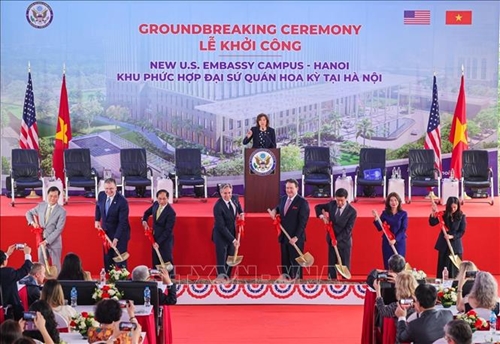The new embassy represents "another significant step towards strengthening the vital partnership between our nations and peoples," U.S. State Secretary Blinken said in his address.
The U.S. Embassy campus has a total investment of 1.2 billion USD, built on 39,000sq.m, on a land area of 3.2 hectares, featuring plenty of greenery.
    |
 |
|
At the groundbreaking ceremony |
The design of the U.S. Embassy complex will combine the modern urban landscape with the natural beauty of Hanoi as well as inspiration from the UNESCO World Heritage of Ha Long Bay.
Most of the construction will be done with recycled materials and the embassy's design will be energy-efficient and flood-resistant. The foundation of the building will be built with basalt stone, available both in Vietnam and the U.S.
The architecture of the campus will stand for the shared commitments of the two countries in sustainability and climate change resilience.
Blinken said this is the day he has been waiting for a long time, adding he first heard about this project when he was still Deputy Secretary of State.
He expressed his gratitude to the Vietnamese Government and the U.S. Embassy’s staff for their efforts to make this historic day into reality.
Over the past 27 years, since the normalization of ties in 1995, the relationship between Vietnam and the U.S. has been continually strengthened. This year marks the 10th anniversary of the Comprehensive Partnership between the two countries. The two countries have cooperated in all aspects, from improving public health to expanding all-encompassing economic opportunities to accelerating the transition to clean energy, Blinken noted.
The new embassy building will be eight stories tall and large enough to accommodate all personnel, according to the U.S. diplomat.
The embassy will also be able to increase the number of consular service windows by four times the current capacity, allowing for more efficient and faster processing of visas and passports for a larger number of people, he noted.
It is estimated that over the course of six years of construction, the project will provide employment for approximately 1,800 local workers and contribute an additional 350 million USD to the Vietnamese economy.
At the event, Vice Chairman of the Hanoi People's Committee Duong Duc Tuan said that the project is the result of many years of efforts by both countries with the active participation of many agencies.
Just before the U.S. Secretary of State's visit, Hanoi authorities approved the detailed planning for the remaining part of the new Cau Giay urban area at a ratio of 1/500 in the planning area with the code D30, which is an important condition for carrying out procedures related to the construction of the embassy.
The Hanoi People's Committee will continue to closely coordinate with central agencies and the U.S. Embassy in the construction process, supporting the project to achieve its goals and timeline.
Source: VNA